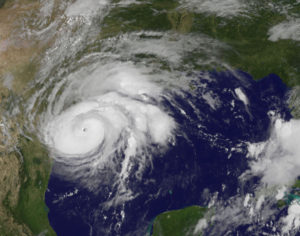Why “Harvey” Was Such A Surprise
NOTE: the original title of this was “Why We Failed to Predict Harvey.” That was read as an indictment of meteorologists by many. Thus the new title of “Why Harvey Was Such a Surprise” to put the focus on the unusal and relatively sudden buildup of storm and rainfall that was beyond the models.
Hurricane Harvey came on suddenly and is still doing catastrophic damage to Texas as this is published. Since flooding is the combined effect of storms, extreme tides, rainfall and rising sea level, it is worth a moment to consider its relevance, even if it might seem a little outside my usual sea level focus. In fact, there is a great connection with rogue storms like Harvey and the broader issue of global warming.
Over the next decade, major storms and heavy rainfall will likely have even more damaging impact on many coastal communities than sea level rise. In the longer term, however, higher ocean levels will dramatically increase the impacts and damage from future storms and heavy rain. Thus they are very connected issues, following the “Five Forms of Flooding” that I use as a perspective to look at the very different major flooding components, which can combine for maximum disaster. (e.g. my recent post: “Deadly Flash Floods On the Rise”)
As you have likely seen in the news about Harvey, huge crashing waves at the coast, storm surge piling up even higher in the bays, and a deluge 40 inches of rainfall have caused massive flooding. It is all expected to get even worse as it spends the next few days on the Texas coast moving slowly eastward towards Houston and Galveston. The shallow warm waters of the northern Gulf and the extensive bays behind the barrier islands can nourish and sustain the downpour.
I should note that I have been particularly absorbed by this hurricane, since just three weeks ago, I was in those very communities––Corpus Christi, Port Aransas, and Galveston –– helping them with a program called “Resilient Texas: Preparing for Rising Sea Level.” I made new friends and colleagues there and am anxious to hear how they fared.
It’s useful to understand why hurricanes like Harvey are now becoming such extreme events. Equally important why they often defy prediction, when we have come to expect that modern meteorology will give us adequate advance notice. Unlike most historic big storms, Harvey did not begin off the horn of Africa and travel across the south Atlantic, giving us a week to monitor and plot their track.
With this very powerful “Cat 4” tropical cyclone, there was hardly any warning. Harvey spun up, almost out of nowhere, in about 36 hours, just south of Texas, forming off the Yucatan Peninsula, which is visible at the bottom of the satellite image above.
So why are we seeing these unpredictable and unusual storms? One reason is the extra heat being trapped in our atmosphere by the increased greenhouse gases is mostly being stored in the ocean––93% to be precise. Extra heat was the force behind Harvey. The Gulf of Mexico is a relatively shallow isolated body of water that is particularly susceptible to warming. I recalled seeing a headline just a few months ago in the Chicago Tribune, Gulf of Mexico waters are freakishly warm, which could fuel strong spring storms It described that the Gulf was an incredible ten degrees above normal.
In simple terms that’s why Harvey hit with minimal notice and is now producing flooding that exceeds all models. It sprung up locally. With the extra heating, certain areas from the Arctic to the Gulf of Mexico are heating faster, changing the ocean and atmospheric patterns that have existed for centuries and millennia.
Unusual weather patterns including storms and record breaking rain, are all related to the warmer ocean. While our usual weather forecasts are becoming extraordinarily accurate, a lot of the big pattern phenomena like hurricanes and el nino’s are getting harder to predict accurately, because we are in uncharted territory, quite different than the last 11,000 years of stability, the era described as the Holocene. Now as many are aware, the scientific community believes we have entered a new geologic period, the Anthropocene –– the era dominated by humans and our effect on the Earth system.
Even the National Weather Service declared, “The breadth and intensity of this rainfall are beyond anything experienced before.”
Finally to note the key issue of flooding that goes beyond abnormal weather. The warmer temperatures are melting vast areas of glaciers and ice sheet. Indisputably that will raise global sea level, far into the future. Sea level reaching levels unknown for more than a hundred thousand years add a whole other dimension to the challenge of flooding.
All of this reinforces my key messages that we must do two things with the highest possible priority:
- Slow the warming on an urgent basis, preferably utilizing economic incentives, as I described in a post on Earth Day.
- Begin preparing for sustained increased flooding from more powerful storms, record rainfall, extreme tides, and ever-increasing sea level rise.
My heart goes out to the people of Texas. Hopefully we will learn from their tragedy and wake up to the fact that we need to take action now.

